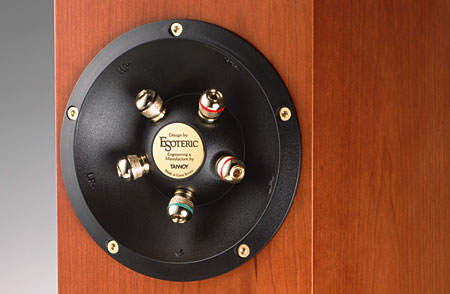| Columns Retired Columns & Blogs |
Esoteric MG-20 loudspeaker Page 2
I kept returning to the Esoteric speaker's resolution and transparency. As I explained in my news article about Cantus, the latest CD I've engineered for the Minnesotan choir of that name (CD, Cantus Recordings CTS-1207), the mix of Peter Hamelin's semi-theatrical setting of Ernest Lawrence Thayer's "Casey at the Bat" was extremely complicated, involving 24 tracks of material: the full choir, a barbershop trio, crowd noises, dialog between the umpire and Casey, various baseball-related sound effects—even birds (if not a kitchen sink). Some of these sounds—the tolling bell in the coda, for example—are very low in level, but when I played the track through the Esoterics, all was clear.
The MG-20s' ability to probe deeply into a recorded soundstage was unaccompanied by any spotlighting of the treble region. This was always something I had felt to be the Achilles' heel of the otherwise superbly transparent MartinLogan CLS electrostatic. In my November 1986 review of the CLS, I had described its reproduction of fine detail as being akin to "reading a book with fine print by the light of a 500W bulb. You are made aware of every detail, including the intricacies of the typeface and the texture of the paper, but you become a little fatigued. You become so aware of the 'how' that you lose interest in the 'why.'" My choice of words did not sit well with the speaker's designer, Gayle Sanders, but I never felt that succeeding iterations of the CLS managed to solve the problem they describe.

By contrast, the MG-20 seemed to achieve its transparency not by thrusting detail at the listener but by suppressing its own spuriae, which would otherwise obscure and confuse recorded information. Years ago, while listening to J. Gordon Holt's big Sound-Lab electrostatics, I understood why he loved the speakers, but always felt that the speaker was "noisy"—that the chaotic motion of its diaphragms reduced the dynamic range of music. The MG-20 was the opposite: there was a "quietness" to its presentation that let me hear more deeply than usual into the soundstage.
For example, I have loved the music of Frederick Delius for 40 years, ever since I first heard his orchestral arrangement of the folk song "Brigg Fair." A favorite Delius CD is the anthology La Calinda (EMI Studio CDM 7 69534 2), which gathers together recordings from the 1960s from the likes of Sirs John Barbirolli, Charles Groves, and Malcolm Sargent. Time has not been kind to these recordings, which suffer from analog tape hiss, modulation noise, and tape saturation. But through the Esoterics, the tape hiss on Meredith Davies and the Philharmonia Orchestra's performance of Walk to the Paradise Garden is separated in space from the sounds of the orchestral instruments, thus reducing its annoyance.
Comparison: PSB Synchrony One
My current reference for realistically priced loudspeakers is PSB's Synchrony One ($4500/pair), which I reviewed in April. Like the Esoteric MG-20, the Synchrony One is a slim, beautifully finished, high-tech tower—although, at 71 lbs vs the MG-20's 33 lbs, it's considerably heavier. The PSB's competitive price is made possible by its being manufactured, as so many speakers are these days, in China.
The PSB had noticeably more low-frequency extension and upper-bass energy than the Esoteric, orchestral recordings had more weight and authority, and male voices sounded larger. But in direct comparison, the Synchrony's bass region sounded less even than the MG-20's, and bass guitar warmer but less precise. The speakers offered similar balances and resolving powers through the midrange and mid-treble regions, though the Esoteric's lighter character was clearly evident. In my review, I had found the PSB to sound a little elevated in the presence region, but this was not evident in comparison with the Esoteric. However, I did find that the MG-20's top two octaves sounded more mellow than those of the Synchrony One.
Which speaker you will prefer will come down to personal needs and musical taste. I would give a slight nod to the Esoteric, but it does cost twice as much as the PSB, even without its optional stands.
Summing up
My recent exploration of floorstanding tower speakers began in December 2007 with the Sonus Faber Cremona Elipsa ($20,800/pair), followed in 2008 by: in February, the KEF Reference 207/2 ($20,000/pair); in April, the PSB Synchrony One ($4500/pair); in May, the Magico V3 ($25,000/pair); and in July, the Avalon NP Evolution 2.0 ($1995/pair). The Esoteric MG-20 joins that select company in being recommended and, in one aspect, even taking the lead. The MG-20 offers electrostatic-like transparency without a concomitantly relentless treble balance, and its low frequencies speak with one voice, offering superb definition and clarity. Its midrange is uncolored, its stereo imaging stable and precisely defined.
At first glance, the relatively small, delicate-looking MG-20 seems expensive at $10,500/pair with dedicated bases. But it is a beautifully finished, well-engineered loudspeaker that, with empathetic ancillaries in a room of small to medium size, will repay that investment with interest. An example is August's "Recording of the Month," the Dowland Project's Romaria (CD, ECM New Series 1970). I first listened to this disc on my office system, but when I got it home and played it through the Esoterics just as I was about to start writing this review, I was overwhelmed. Tenor John Potter just hung in front of me, the sounds of the supporting instruments illuminating and delineating the recording space, yet none of this technical precision was achieved by the speakers diluting the musical message. It doesn't get much better than that.
Esoteric's MG-20 is a shoo-in for the "Class A (Limited LF Extension)" category of Stereophile's "Recommended Components."
- Log in or register to post comments




































